-
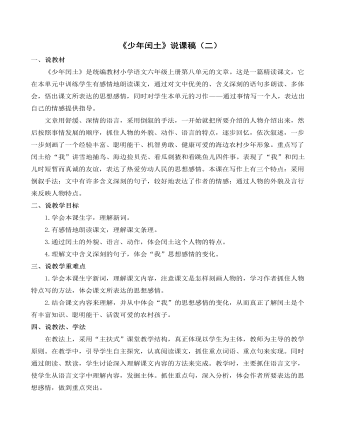
部编人教版六年级上册《少年闰土》说课稿(二)
二、说教学目标 1.学会本课生字,理解新词。 2.有感情地朗读课文,理解课文条理。 3.通过闰土的外貌、语言、动作,体会闰土这个人物的特点。4.理解文中含义深刻的句子,体会“我”思想感情的变化。 三、说教学重难点 1.学会本课生字新词,理解课文内容,注意课文是怎样刻画人物的,学习作者抓住人物特点写的方法,体会课文所表达的思想感情。 2.结合课文内容来理解,并从中体会“我”的思想感情的变化,从而真正了解闰土是个有丰富知识、聪明能干、活泼可爱的农村孩子。四、说教法、学法在教法上,采用“主扶式”课堂教学结构,真正体现以学生为主体,教师为主导的教学原则。在教学中,引导学生自主探究,认真阅读课文,抓住重点词语、重点句来实现。同时通过朗读、默读,学生讨论深入理解课文内容的方法来完成。教学时,主要抓住语言文字,使学生从语言文字中理解内容,发掘主体。抓住重点句,深入分析,体会作者所要表达的思想感情,做到重点突出。

2023年工作总结和2024年工作思路汇编(7篇)
4.营商环境不断优化。打造营商环境品牌。围绕市场服务、产业服务等七个方面提出多项攻坚举措,编制《无锡经济开发区2023年度优化营商环境提升行动方案》。根据省委第二轮巡视发现问题清单,组织各部门自查自纠并提出工作计划,进一步压实主体责任,发扬“店小二”精神,持续打造“无难事、悉心办”的营商环境品牌。落实各项政策,发放区级扶持资金X亿元,惠及企业超400家。开展为企服务活动。举办“企业家迎春座谈会”、“企业家协会成立大会”等活动,及时了解企业现状,优化政企沟通交流渠道,构建亲清政商关系。完善政企沟通机制,各项政策通过亲清在线进行公示,并通过建立工作群、园区专人负责指导等形式全方位宣传,各类惠企政策奖补范围扩大、认定门槛降低。此外成立“无难事、悉心办”锡企服务平台(惠企通)经开区工作协调推进小组,升级原有“惠企通”平台,建设“经开区锡企服务旗舰店”;组建“锡企小助手”团队,明确“首问应答员”“政策辅导员”“服务监督员”等业务骨干人员。提升信用服务水平。在帮助企业融资方面,经开区开展2023年度市场主体融资注册工作部署会议,发动各街道、各园区亲自帮扶,助力解决市场主体融资难、融资贵等问题,报送注册信息4109条。
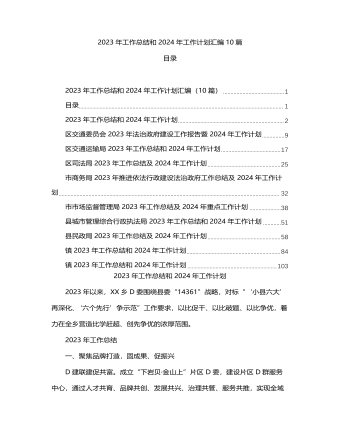
2023年工作总结和2024年工作计划汇编(10篇)
截至11月,我镇强镇富村公司营业额已完成XX万的营业额,公司逐步迈入经营正轨。六是深入推进绿美广东生态建设。积极开展义务植树活动,组织全镇干部职工、志愿者开展义务植树2次,积极组织干部、群众开展“我为绿美韶关添新绿”认种认捐活动、“XX县古树名木认捐认养活动”等,以镇一把手负总责,分管领导具体抓,切实把我镇林长制“五进”工作抓紧抓实。七是抓好和美乡村建设及人居环境整治。稳步推进美丽乡村村庄提升建设工程、农村人居环境整治项目的后续结算工作,蓝田村、小溪村、古竹村3个行政村24个自然村,共投入资金XX万余元,主要进行农村污水处理设施、雨污分流、村卷道、垃圾收集点建设,目前工程已完成竣工验收,力争第四季度完成工程项目的结算事宜。积极推进农村无害卫生户厕改造工作,2023年新增无害化卫生户厕提升改造157户,已完成改造并通过验收合格3户,154户正在按相关程序申请改造,争取第四季度完成改造任务。持续开展农村“村庄清洁日”活动,进行“三清三拆三整治”,有效提升农村村容村貌。四是做好第四季度农村基础设施排查整改及督导工作。截至第三季度我镇共支出农村基础设施管护费XX元,其中集中供水管护XX元,污水设施管护XX元,基础设施管护XX元,通过管护确保农村基础设施正常运行。
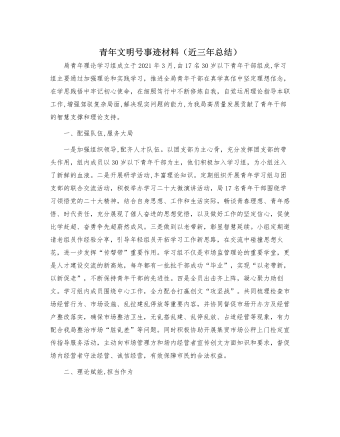
青年文明号事迹材料(近三年总结)
三、服务群众,提质增效一是主动作为,助力优化营商环境。青年干部认真落实企业诉求快速响应机制,并在老组员的指导下精准及时响应平台内的企业诉求,并提供解疑释惑的贴心服务,为优化我市营商环境舔砖加瓦。另一方面青年干部主动担起“推广大使”职责,积极推广商事登记全程“网上办”、“AAA智能办”、执照智能审批、执照快递上门等服务内容,并通过线上网办咨询与办事大厅线下服务有机结合,耐心指导群众办事实现“免预约”“全天候”“不见面审批”,以数据的多跑路切实减少了群众的少跑腿,青年干部以实际行动推动数字政府建设不断深化。二是强化监管,确保食品安全落实到位。在老组员的带领下,青年干部积极深入开展食品监督抽检1564批次,并参与创建国家食品安全示范城市工作,通过定制并不断更新市食品安全“两个责任”落实信息公开栏,专门印发“两个手册”(《包保干部工作手册》和《企业落实食品安全主体责任工作手册》),落实食品安全“两个责任”,并推动完成创建广东省食品安全示范县验收工作。

2023年工作总结及2024年工作计划汇编(5篇)
(一)深入学习贯彻新时代中国特色社会主义思想主题教育坚持学习贯彻新时代中国特色社会主义思想作为全县民委成员单位当前和今后一个时期首要政治任务。把学习贯彻新时代中国特色社会主义思想与贯彻落实关于加强和改进民族工作的重要思想和对内蒙古的重要指示批示精神有机结合起来,与贯彻落实中央、自治区D委和市委、县委民族工作会议精神有机结合起来。制定学习计划,创新学习宣传方法和载体,每周通过线上线下学习2次,采取集体学习、学习研讨、专题讲座等多种形式,教育引导D员干部深学细悟、学懂弄通,将学习成效转化为民委工作的生动实践。(二)推进中华民族共有精神家园建设取得成效一是以铸牢中华民族共同体意识为主线,建立创建考核、动态管理、示范带动“三大体系”,积极争创全国民族团结进步示范县。健全完善创建指标和示范单位动态调整机制,研究制定了《和林格尔县民族团结进步示范单位命名管理办法(试行)》,支持和指导相关地区和单位争创复创全区、全市民族团结进步示范区(单位)。
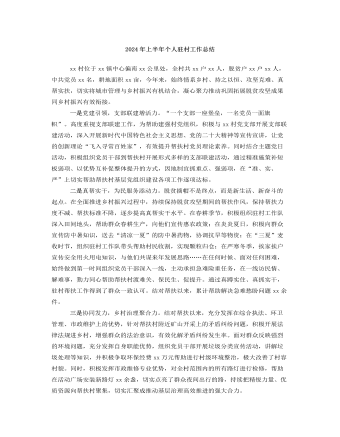
2024年上半年个人驻村工作总结(乡村振兴)
四是多措并举,产业发展尽全力。始终把产业振兴作为帮扶工作重点,帮扶之初,引导驻村工作队积极通过实地调研、培训学习等方式,组织村“两委”、产业发展能人等,集中学习产业发展相关政策、技能,外出到周边产业发展示范村等地参观学习取经,让村“两委”干部学习到先进的生产技术和管理经验,帮助他们开拓眼界、打开思路、提升技能,结合村情实际及时制定产业发展规划,最终经过多方考量、征求意见,确定以种植大棚蔬菜、精品水果和油茶等经济作物的产业发展思路。同时,还组织园林维护干部到帮扶村宣传常见病虫害及防治知识,传授种植和修剪技能,帮助提升技能技术,高效发展产业,通过签订分红合同等方式,引导企业、合作社与农户建立“风险共担、农企双赢”的利益联结机制,促进农户共享稳定收益,实现集体增收、群众致富。截至目前,共争取到项目资金、物资xx余万元,帮助发展蔬菜等xx余亩,仅2024年上半年实现销售收入xx余万元,覆盖带动全村xx户脱贫户稳定增收。
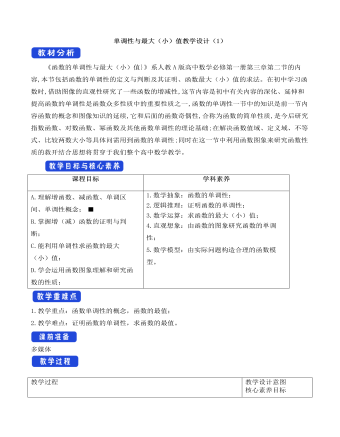
人教A版高中数学必修一单调性与最大(小)值教学设计(1)
《函数的单调性与最大(小)值}》系人教A版高中数学必修第一册第三章第二节的内容,本节包括函数的单调性的定义与判断及其证明、函数最大(小)值的求法。在初中学习函数时,借助图像的直观性研究了一些函数的增减性,这节内容是初中有关内容的深化、延伸和提高函数的单调性是函数众多性质中的重要性质之一,函数的单调性一节中的知识是前一节内容函数的概念和图像知识的延续,它和后面的函数奇偶性,合称为函数的简单性质,是今后研究指数函数、对数函数、幂函数及其他函数单调性的理论基础;在解决函数值域、定义域、不等式、比较两数大小等具体问需用到函数的单调性;同时在这一节中利用函数图象来研究函数性质的救开结合思想将贯穿于我们整个高中数学教学。
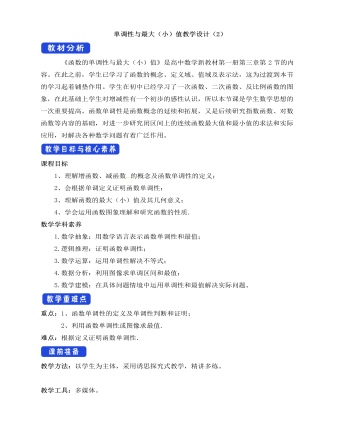
人教A版高中数学必修一单调性与最大(小)值教学设计(2)
《函数的单调性与最大(小)值》是高中数学新教材第一册第三章第2节的内容。在此之前,学生已学习了函数的概念、定义域、值域及表示法,这为过渡到本节的学习起着铺垫作用。学生在初中已经学习了一次函数、二次函数、反比例函数的图象,在此基础上学生对增减性有一个初步的感性认识,所以本节课是学生数学思想的一次重要提高。函数单调性是函数概念的延续和拓展,又是后续研究指数函数、对数函数等内容的基础,对进一步研究闭区间上的连续函数最大值和最小值的求法和实际应用,对解决各种数学问题有着广泛作用。课程目标1、理解增函数、减函数 的概念及函数单调性的定义;2、会根据单调定义证明函数单调性;3、理解函数的最大(小)值及其几何意义;4、学会运用函数图象理解和研究函数的性质.数学学科素养
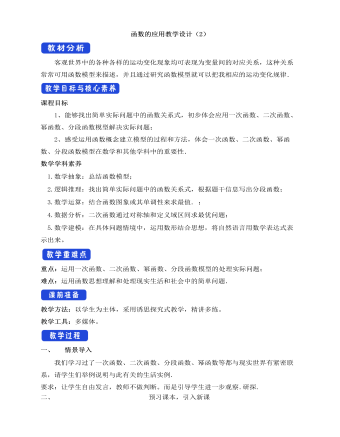
人教A版高中数学必修一函数的应用(一)教学设计(2)
客观世界中的各种各样的运动变化现象均可表现为变量间的对应关系,这种关系常常可用函数模型来描述,并且通过研究函数模型就可以把我相应的运动变化规律.课程目标1、能够找出简单实际问题中的函数关系式,初步体会应用一次函数、二次函数、幂函数、分段函数模型解决实际问题; 2、感受运用函数概念建立模型的过程和方法,体会一次函数、二次函数、幂函数、分段函数模型在数学和其他学科中的重要性. 数学学科素养1.数学抽象:总结函数模型; 2.逻辑推理:找出简单实际问题中的函数关系式,根据题干信息写出分段函数; 3.数学运算:结合函数图象或其单调性来求最值. ; 4.数据分析:二次函数通过对称轴和定义域区间求最优问题; 5.数学建模:在具体问题情境中,运用数形结合思想,将自然语言用数学表达式表示出来。 重点:运用一次函数、二次函数、幂函数、分段函数模型的处理实际问题;难点:运用函数思想理解和处理现实生活和社会中的简单问题.
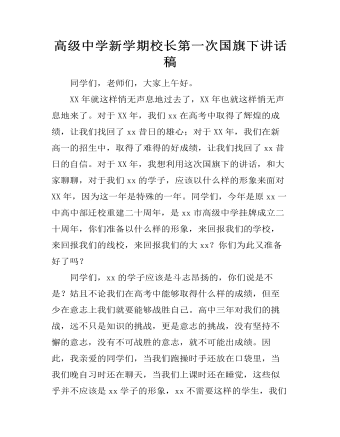
高级中学新学期校长第一次国旗下讲话稿
同学们,老师们,大家上午好。XX年就这样悄无声息地过去了,XX年也就这样悄无声息地来了。对于XX年,我们xx在高考中取得了辉煌的成绩,让我们找回了xx昔日的雄心;对于XX年,我们在新高一的招生中,取得了难得的好成绩,让我们找回了xx昔日的自信。对于XX年,我想利用这次国旗下的讲话,和大家聊聊,对于我们xx的学子,应该以什么样的形象来面对XX年,因为这一年是特殊的一年。同学们,今年是原xx一中高中部迁校重建二十周年,是xx市高级中学挂牌成立二十周年,你们准备以什么样的形象,来回报我们的学校,来回报我们的线校,来回报我们的大xx?你们为此又准备好了吗?同学们,xx的学子应该是斗志昂扬的,你们说是不是?姑且不论我们在高考中能够取得什么样的成绩,但至少在意志上我们就要能够战胜自己。高中三年对我们的挑战,远不只是知识的挑战,更是意志的挑战,没有坚持不懈的意志,没有不可战胜的意志,就不可能出成绩。因此,我亲爱的同学们,当我们跑操时手还放在口袋里,当我们晚自习时还在聊天,当我们上课时还在睡觉,这些似乎并不应该是xx学子的形象,xx不需要这样的学生,我们也不忍心看到我们的学生有这份模样。你们要有你们自己的精神,你们要有你们自己的意志,这可能和我们不一样,但你得有精神,你得有意志,否则大家就会瞧不起你。同学们,我们需要有个性的学生,但我们不需要颓废的学生。

人教版高中政治必修1新时代的劳动者说课稿
第一环节:关于劳动光荣和就业的意义。这两个问题学生在自主阅读的基础上,教师设疑,给出两个人物事迹,一是农民工刘俊刚把青春献给第二个家乡的城市美容师;一是北大学子李彦宏自主创业,创建百度公司,启发学生比较、思考。很多学生倾向于要做李彦宏,教师则适时引导:难道清洁工的劳动不重要吗?经过辩论,归纳出劳动和就业的意义。接着利用教材中李师傅的事例,进行问题探究,“李师傅找不到工作的原因是什么?”从主客观两方面分析,带着问题进入到下一环节学习。第二环节:突出重点。多媒体展示:通过数字的列举及对占有材料的分析,既看到了我国就业形势严峻,也介绍了国家关注民生,实施积极的就业政策。在此基础上,教师启发学生归纳“我国就业严峻的原因及对策?”学生把教材理论与生活中的现实材料相结合,进行探究,得出就业形势严峻的主要原因及其相应对策。
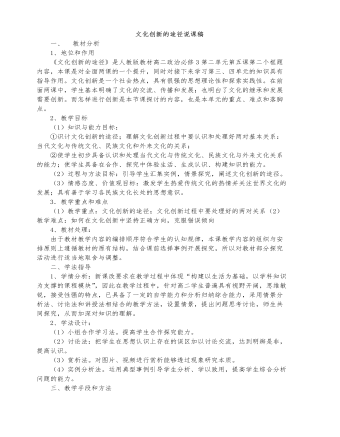
人教版高中政治必修3文化创新的途径说课稿
一、 教材分析1、地位和作用《文化创新的途径》是人教版教材高二政治必修3第二单元第五课第二个框题内容,本课是对全面两课的一个提升,同时对接下来学习第三、四单元的知识具有指导作用。文化创新是一个社会热点,具有很强的思想理论性和探索实践性。在前面两课中,学生基本明确了文化的交流、传播和发展;也明白了文化的继承和发展需要创新。而怎样进行创新是本节课探讨的内容,也是本单元的重点、难点和落脚点。2、教学目标(1)知识与能力目标:①识计文化创新的途径;理解文化创新过程中要认识和处理好两对基本关系:当代文化与传统文化、民族文化和外来文化的关系;②使学生初步具备认识和处理当代文化与传统文化、民族文化与外来文化关系的能力;使学生具备在合作、探究中体验生活、生成认识、构建知识的能力。

新人教版高中英语必修3Unit 1 Festivals and Celebrations教学设计二
1. Ss look at the picture and scan the passage to understand the main idea while teacher is giving the following questions to inspire Ss to think.*Where are those people?*What are they doing?*Why are they so excited?2. Ss complete the passage with the appropriate -ing form. Then discuss and check the answers with class.Answers: boring, interesting, taking, exciting, amazing3. The teacher raises questions for the students to discuss and encourages them to express their opinions.*Do you like La Tomatina? Why or why not?4. Each group representative reports the discussion result, the teacher gives feedback and the evaluation.Step 6 PracticeActivity 41. Ss complete the Ex 2 in Using structures.2. Check the answers after finishing the exercises.①The dragon boat races are the most exciting part of the Dragon Boat Festival.② The children were excited to go Easter egg hunting.③What an amazing performance! This is the best music festival I have ever been to.④We were amazed by her funny-looking hat.⑤His inspiring speech at the conference won the admiration/ favour of the audience.⑥This is a challenging game to test your memory and observation capabilities. 3. T asks Ss to finish Ex 3 and 4 in Using structures by themselves, then check the answers with class.Step 6 Homework1. Understand and master the functions and usage of the -ing form;2. Finish the other exercises in Using structures.1、通过本节内容学习,学生是否理解和掌握动词-ing形式作定语和表语的功能和意义;2、通过本节内容学习,学生能否在理解文段内容的基础上,根据上下文语境和表达逻辑,能正确运用动词-ing形式描述节日庆典。3、通过本节内容学习,学生是否归纳和积累用于表达情绪的相关词汇。

新人教版高中英语必修3Unit 1 Festivals and Celebrations教学设计一
本板块的活动主题是“谈论节日活动”(Talk about festival activities),主要是从贴近学生日常生活的角度来切入“节日”主题。学生会听到发生在三个国家不同节日场景下的简短对话,对话中的人们正在参与或将要亲历不同的庆祝活动。随着全球化的进程加速,国际交流日益频繁,无论是国人走出国门还是外国友人访问中国,都已成为司空见惯的事情。因此,该板块所选取的三个典型节日场景都是属于跨文化交际语境,不仅每组对话中的人物来自不同的文化背景,对话者的身份和关系也不尽相同。1. Master the new words related to holiday: the lantern, Carnival, costume, dress(sb)up, march, congratulation, congratulate, riddle, ceremony, samba, make - up, after all. 2. To understand the origin of major world festivals and the activities held to celebrate them and the significance of these activities;3. Improve listening comprehension and oral expression of the topic by listening and talking about traditional festivals around the world;4. Improve my understanding of the topic by watching pictures and videos about different traditional festivals around the world;5. Review the common assimilation phenomenon in English phonetics, can distinguish the assimilated phonemes in the natural language flow, and consciously use the assimilation skill in oral expression. Importance:1. Guide students to pay attention to the attitude of the speaker in the process of listening, and identify the relationship between the characters;2. Inspire students to use topic words to describe the festival activities based on their background knowledge. Difficulties:In the process of listening to the correct understanding of the speaker's attitude, accurately identify the relationship between the characters.

新人教版高中英语必修3Unit 2 Morals and Virtues教学设计二
Activity 41. Students complete the task of activity 4, then teachers and students check the answers. 2. The teacher organized the students to work together and asked them to use the tables and mind maps sorted out before to retold the important choices in Lin Qiaozhi's life and their resultsStep 5 Language points1. The teacher asks the students to read the text carefully, find out the core words and long and difficult sentences in the text and draw lines, understand the use of vocabulary, and analyze the structure of long and difficult sentences. 2. The teacher explains and summarizes the usage of core vocabulary and asks the students to take notes. 3. The teacher analyzes and explains the long and difficult sentences that the students don't understand, so that the students can understand them better. Step 6 Homework1. Read the text again, in-depth understanding of the text; 2. Master the use of core vocabulary and understand the long and difficult sentences. 3. Complete relevant exercises in the guide plan. 1、通过本节内容学习,学生是否理解和掌握阅读文本中的新词汇的意义与用法;2、通过本节内容学习,学生能否结合文本特点总结林巧稚的人生原则和人格品质特征;3、通过本节内容学习,学生能否针对人生抉择发表自己的看法;能否全面地、客观地、理性地看待问题,进而对道德和人性有更加深入的思考和理解。

新人教版高中英语必修3Unit 1 Festivals and Celebrations教学设计三
*wide range of origins(= a great number of different origins, many kinds of origins)*It featured a parade and a great feast with music, dancing, and sports. (=A parade and a great feast with music, dancing, and sports were included as important parts of the Egyptian harvest festival.)*.. some traditions may fade away and others may be established.(= Some traditions may disappear gradually, while other new traditions may come into being.)Step 6 Practice(1) Listen and follow the tape.The teacher may remind the students to pay attention to the meaning and usage of the black words in the context, so as to prepare for the completion of the blanks in activity 5 and vocabulary exercises in the exercise book.(2) Students complete the text of activity 5 by themselves.The teacher needs to remind the students to fill in the blanks with the correct form of the vocabulary they have learned in the text.Students exchange their answers with their partners, and then teachers and students check their answers.(3)Finish the Ex in Activity 5 of students’ book.Step 7 Homework1. Read the text again, in-depth understanding of the text;2. Discuss the origin of festivals, the historical changes of related customs, the influence of commercial society on festivals and the connotation and essential meaning of festivals.3. Complete relevant exercises in the guide plan.1、通过本节内容学习,学生是否理解和掌握阅读文本中的新词汇的意义与用法;2、通过本节内容学习,学生能否结合文本特点快速而准确地找到主题句;3、通过本节内容学习,学生能否理清论说文的语篇结构和文本逻辑,了解节日风俗发展与变迁,感悟节日的内涵与意义。

新人教版高中英语必修3Unit 2 Morals and Virtues教学设计三
The joke set her crying.这个玩笑使她哭起来。Step 5 ReadingActivity 31. Students read the small text in activity 3. The teacher provides several small questions to check whether students understand the content of the text and the ideographic function of the -ing form in the text.*Where are those people?*Why did Dr Bethune come to China?*How did he help the Chinese people during the war?*What did Chairman Mao Zedong say about him?2. Ss try to rewrite some sentences using the -ing form. Then check the answers. When checking the answers, the teacher can ask different students to read the rewritten sentences and give comments.Answers:1. he became very interested in medicine, deciding to become a doctor.2. …after hearing that many people were dying in the war.3. Helping to organise hospitals, he taught doctors and nurses, and showed people how to give first aid./ He helped to organise hospitals, teaching doctors and nurses, and showing people how to give first aid.4. …praising Dr Bethune as a hero to be remembered in China.Step 6 PracticeActivity 4Students complete grammar activities 2 and 3 on page 69 of the workbook.Step 6 Homework1. Understand and master the functions and usage of the -ing form;2. Finish the other exercises in Using structures.1、通过本节内容学习,学生是否理解和掌握动词-ing形式作宾语补足语语和状语语的功能和意义;2、通过本节内容学习,学生能否正确使用动词-ing形式描述人物的行为、动作及其经历;3、通过本节内容学习,学生能否独立完成练习册和导学案中的相关练习。

新人教版高中英语必修3Unit 2 Morals and Virtues教学设计四
3.Teachers ask different groups to report the answers to the questions and ask them to try different sentence patterns.The teacher added some sentence patterns for students to refer to when writing.Step 4 Writing taskActivity 51.Write the first draft.Students first review the evaluation criteria in activity 5, and then independently complete the draft according to the outline of activity 4, the answers to the questions listed in the group discussion and report, and the reference sentence pattern.2.Change partners.The teacher guides the students to evaluate their partner's composition according to the checklist of activity 5 and proposes Suggestions for modification.3.Finalize the draft.Based on the peer evaluation, students revise their own compositions and determine the final draft.Finally, through group recommendation, the teacher selects excellent compositions for projection display or reading aloud in class, and gives comments and Suggestions.Step 5 Showing writingActivity 5T call some Ss to share their writing.Step 6 Homework1. Read the passage in this section to better understand the passage.2. Carefully understand the hierarchical structure of the article, and deeply understand the plot of the story according to the causes, process and results;3. Independently complete the relevant exercises in the guide plan.1、通过本节内容学习,学生是否理解和掌握阅读文本中的新词汇的意义与用法;2、通过本节内容学习,学生能否通过人物言行的对比分析道德故事的深层内涵;3、通过本节内容学习,学生能否根据故事的起因、经过和结果来深入理解故事的情节,从而了解文章的层次结构;4、结合现实生活案例发表自己的见解和看法,写一篇观点明确、层次分明的故事评论。

新人教版高中英语必修3Unit 2 Morals and virtues教学设计一
(2) students are divided into groups according to the requirements of activity 3. Each student shares a story of personal experience or hearing-witnessing kindness, and then selects the most touching story in the group and shares it with the whole class. Before the students share the story, the teacher can instruct them to use the words and sentence patterns in the box to express. For example, the words in the box can be classified:Time order: first of all, then, after that, later, finally logical relationship :so, however, although, butTeachers can also appropriately add some transitional language to enrich students' expression:Afterwards, afterwards, at last, in the end, eventuallySpatial order: next to, far from, on the left, in front ofOtherwise, nevertheless, as a result, therefore, furthermore, in addition, as well asSummary: in a word, in short, on the whole, to sum up, in briefStep 8 Homework1. Understand the definition of "moral dilemma" and establish a correct moral view;2. Accumulate vocabulary about attitudes and emotions in listening texts and use them to express your own views;3. Complete relevant exercises in the guide plan.1、通过本节内容学习,学生能否理解理解“道德困境”的定义;2、通过本节内容学习,学生能否通过说话人所表达的内容、说话的语气、语调等来判断其态度和情绪;3、通过本节内容学习,学生能否针对具体的道德困境发表自己的看法和见解,能否掌握听力理训练中的听力策略。

新人教版高中英语必修3Unit 3 Diverse Cultures教学设计三
The price is the same as(the price was)before the war.价格与战前相同。(4)定语从句中的“关系代词+助动词be”可以省略。The ticket(that/which was)booked by his sister has been sent to him.他妹妹订的那张票已送到了他那里。Step 5 PracticeActivity 3(1) Guide students to complete the four activities in the Using Structures part of exercise book, in which activities 1 and 2 focus on ellipsis in dialogue answers, activity 3 focus on signs and headlines, two typical situations where ellipsis is used, and activity 4 focus on ellipsis in diary, an informal style.(2) Combine the examples in the above activities, ask students to summarize the omitted situations in groups, and make their own summary into a poster, and post it on the class wall after class to share with the class.(This step should give full play to the subjectivity of students, and teachers should encourage students to conclude different ellipsis phenomena according to their own understanding, they can conclude according to the different parts omitted in the sentence.)Step 6 Homework1. Understand and master the usages of ellipsis;2. Finish the other exercises in Using structures of Workbook.1、通过本节内容学习,学生是否理解和掌握省略的用法;2、通过本节内容学习,学生能否根据上下文语境或情景恢复句子中省略的成分,体会使用省略的效果;3、通过本节内容学习,学生能否独立完成练习册和导学案中的相关练习。




